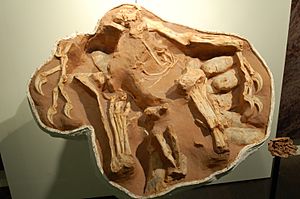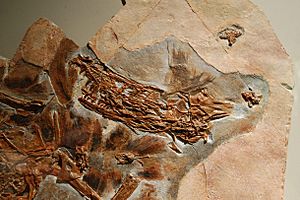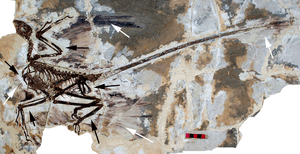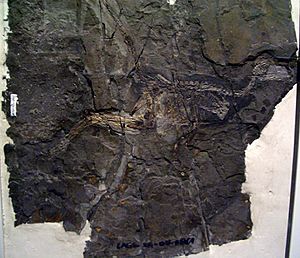Feathered dinosaur facts for kids
A feathered dinosaur is a dinosaur that had feathers. Scientists now think that many dinosaurs, especially those called coelurosaurs and theropods, probably had feathers. This idea came about because dinosaurs are closely related to birds.
For a long time, the only dinosaur-like fossil found with clear feathers was Archaeopteryx. But in the early 1990s, amazing new fossils were found. These fossils showed that many dinosaurs that were definitely not birds also had feathers! Today, we know of about 40 different types of theropod dinosaurs that had feathers.
Most of these incredible fossils come from a special place in China called the Yixian formation. The feathers of one dinosaur, Shuvuuia deserti, were even tested. Scientists found beta-keratin in them, which is the main protein that makes up bird feathers today!
Contents
Finding Feathered Dinosaurs

For over a hundred years, people didn't have clear proof of feathered dinosaurs. Then, in the 1990s, beautifully preserved fossils started appearing. More are still being found! These fossils came from a special type of sedimentary rock deposit in Liaoning, China. Scientists call such a place a "Lagerstätte" because it preserves fossils in amazing detail.
This area was covered in volcanic ash about 124 million years ago, during the Lower Cretaceous period. The ash came from volcanoes in Inner Mongolia. This fine ash buried living things quickly and gently, keeping them in perfect condition. The area was full of life! Millions of leaves, flowering plants, insects, fish, frogs, salamanders, mammals, turtles, and crocodilians have been found there.
The most exciting finds from Liaoning are the many feathered dinosaur fossils. Each new discovery helps us understand how dinosaurs are connected to birds. It also teaches us about how feathers and flight developed over time. For example, scientists found small bumps called "quill knobs" on the arm bone (ulna) of a Velociraptor mongoliensis. These bumps are where large flight feathers would have been attached, just like on modern birds!

We also have fossils that show how these dinosaurs behaved, similar to birds. One amazing fossil shows an oviraptorosaur dinosaur sitting on its nest. Its forearms were folded in a way that looks just like a bird protecting its eggs. Even though no feathers were preserved on this specific fossil, it's very likely they were there. Feathers would have helped keep the eggs and baby dinosaurs warm.
Feathers Trapped in Amber
Imagine finding a dinosaur tail perfectly preserved! In 2016, scientists found the feathered tail of a non-bird theropod dinosaur trapped in amber. This amber came from Myanmar and is about 99 million years old. The BBC called it "perfectly preserved."
A researcher named Lida Xing found it at an amber market. The piece of amber was already polished to be used in jewelry. The seller thought it was just plant material! But it was actually the tail of a feathered dinosaur, about the size of a sparrow. The feathers were not for flying. Dr. Paul Barrett from London's Natural History Museum called it a "beautiful fossil" and a "really rare" find.
In 2011, other pieces of amber were found with preserved feathers from the Cretaceous period. These feathers came from both dinosaurs and early birds. Early studies suggest that some of these feathers were used for keeping warm, not for flying.
Dinosaurs with Feathers



Scientists have found direct proof of feathers on many non-bird dinosaurs. This proof can be:
- Clear impressions of feathers left in the rock.
- Skeletal evidence, like the "quill knobs" on bones where feathers would attach.
- A pygostyle, which is a fused tailbone that supports large tail feathers, like in birds.
Here are some of the most well-known feathered dinosaurs, listed by when their feather evidence was first reported:
- Archaeopteryx (1861): This early bird-like creature definitely had flight feathers. It looked like a small meat-eating dinosaur with wings.
- Sinosauropteryx prima (1996): This was the first non-bird dinosaur found with clear feather impressions.
- Protarchaeopteryx robusta (1997)
- Caudipteryx zoui (1998): This dinosaur had clear feather impressions and even preserved stomach contents!
- Shuvuuia deserti (1999)
- Sinornithosaurus millenii (1999)
- Beipiaosaurus inexpectus (1999)
- Microraptor zhaoianus (2000): This dinosaur had feathers on all four limbs, like two sets of wings!
- Dilong paradoxus (2004)
- Jinfengopteryx elegans (2005)
- Velociraptor mongoliensis (inferred 2007): Evidence from quill knobs.
- Epidexipteryx hui (2008)
- Yutyrannus huali (2012): A large tyrannosaur with feathers!
- Ornithomimus edmontonicus (2012)
- Changyuraptor yangi (2014)
- Yi qi (2015): This dinosaur had bat-like wings made of skin and feathers.
Some other dinosaurs, like Psittacosaurus and Tianyulong, and even flying reptiles called pterosaurs, had hair-like or bristle-like structures. Scientists are still studying if these are related to feathers or something different.
Related pages
Images for kids
-
The famous Berlin Archaeopteryx fossil.
-
A fossil footprint from a theropod dinosaur, possibly showing feather impressions around its belly.
See also
 In Spanish: Dinosaurios con plumas para niños
In Spanish: Dinosaurios con plumas para niños






